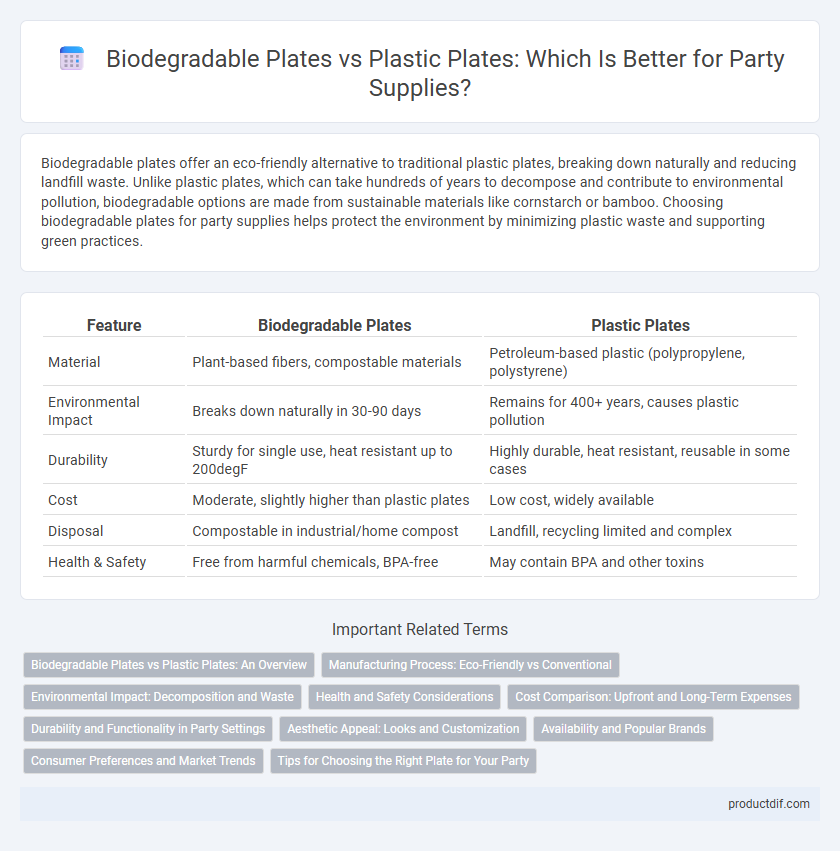Biodegradable plates offer an eco-friendly alternative to traditional plastic plates, breaking down naturally and reducing landfill waste. Unlike plastic plates, which can take hundreds of years to decompose and contribute to environmental pollution, biodegradable options are made from sustainable materials like cornstarch or bamboo. Choosing biodegradable plates for party supplies helps protect the environment by minimizing plastic waste and supporting green practices.
Table of Comparison
| Feature | Biodegradable Plates | Plastic Plates |
|---|---|---|
| Material | Plant-based fibers, compostable materials | Petroleum-based plastic (polypropylene, polystyrene) |
| Environmental Impact | Breaks down naturally in 30-90 days | Remains for 400+ years, causes plastic pollution |
| Durability | Sturdy for single use, heat resistant up to 200degF | Highly durable, heat resistant, reusable in some cases |
| Cost | Moderate, slightly higher than plastic plates | Low cost, widely available |
| Disposal | Compostable in industrial/home compost | Landfill, recycling limited and complex |
| Health & Safety | Free from harmful chemicals, BPA-free | May contain BPA and other toxins |
Biodegradable Plates vs Plastic Plates: An Overview
Biodegradable plates are made from natural materials such as cornstarch, sugarcane, or bamboo, offering an eco-friendly alternative to traditional plastic plates that are petroleum-based and non-degradable. These biodegradable options decompose within months in composting conditions, significantly reducing landfill waste compared to plastic plates that can persist for hundreds of years. Choosing biodegradable plates supports sustainable party planning by minimizing environmental impact while maintaining the convenience of disposable dinnerware.
Manufacturing Process: Eco-Friendly vs Conventional
Biodegradable plates are produced using natural materials like cornstarch, sugarcane bagasse, or bamboo fibers through eco-friendly manufacturing processes that minimize energy use and eliminate toxic chemicals, reducing environmental impact. In contrast, conventional plastic plates are made from petroleum-based polymers derived through energy-intensive processes involving fossil fuels and harmful emissions. The sustainable production of biodegradable plates supports waste reduction and a lower carbon footprint compared to the conventional plastic plate manufacturing process.
Environmental Impact: Decomposition and Waste
Biodegradable plates break down naturally within months, significantly reducing landfill waste and harmful microplastics that persist for centuries when using plastic plates. Plastic plates contribute to long-term environmental pollution due to their resistance to decomposition and potential to release toxic chemicals. Choosing biodegradable plates supports sustainable waste management by minimizing ecological damage and promoting faster organic recycling.
Health and Safety Considerations
Biodegradable plates made from natural materials like cornstarch or bamboo reduce exposure to harmful chemicals often released by plastic plates, enhancing food safety during use. Plastic plates contain additives such as BPA and phthalates, which may leach into food and pose health risks, especially when exposed to heat. Choosing biodegradable plates supports safer consumption by minimizing toxic chemical contact and promoting environmental well-being.
Cost Comparison: Upfront and Long-Term Expenses
Biodegradable plates typically have a higher upfront cost compared to plastic plates due to eco-friendly materials and manufacturing processes. Over time, the long-term expenses associated with biodegradable plates may decrease as they reduce environmental cleanup costs and waste management fees. Plastic plates often appear cheaper initially but can lead to higher indirect costs such as landfill fees and environmental impact mitigation.
Durability and Functionality in Party Settings
Biodegradable plates offer eco-friendly disposal but may lack the durability required for heavy or hot foods, often becoming soggy or breaking under pressure. Plastic plates provide superior sturdiness and resistance to heat, making them more reliable for serving diverse party dishes and beverages. Choosing between the two depends on balancing environmental concerns with the need for functional performance in dynamic party environments.
Aesthetic Appeal: Looks and Customization
Biodegradable plates offer a natural, rustic aesthetic that complements eco-friendly and outdoor-themed parties, showcasing organic textures and earthy tones. Plastic plates provide a glossy, uniform appearance with vibrant color options and easily customizable designs through printing or embossed patterns. Customization on plastic plates allows for precise branding and themed graphics, while biodegradable options often feature subtle, handcrafted variations enhancing a unique visual charm.
Availability and Popular Brands
Biodegradable plates are increasingly available in major retailers and eco-friendly stores, with popular brands like World Centric, Eco-Products, and Repurpose leading the market. Plastic plates, widely stocked by large chains such as Hobby Lobby, Walmart, and Party City, offer a broad range of colors and designs but face growing scrutiny due to environmental concerns. The shift toward biodegradable options reflects rising consumer demand for sustainable party supplies, influencing availability and brand prominence.
Consumer Preferences and Market Trends
Consumers increasingly favor biodegradable plates over plastic plates due to growing environmental awareness and eco-friendly lifestyle choices. Market trends indicate a rising demand for sustainable party supplies, with biodegradable options gaining popularity in both retail and event planning sectors. Biodegradable plates offer a competitive edge by appealing to eco-conscious buyers seeking products that reduce plastic waste and support green initiatives.
Tips for Choosing the Right Plate for Your Party
Choose biodegradable plates made from materials like bamboo, sugarcane, or palm leaves for eco-friendly parties that reduce plastic waste. Consider the type of party, guest count, and meal type to select plates that balance durability and convenience, ensuring they hold up to hot or greasy foods without bending. Prioritize compostable options certified by organizations such as the Biodegradable Products Institute (BPI) to minimize environmental impact while maintaining functionality.
Biodegradable Plates vs Plastic Plates Infographic

 productdif.com
productdif.com